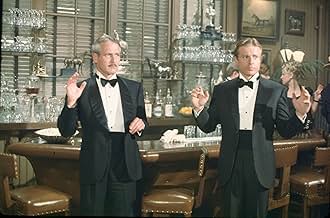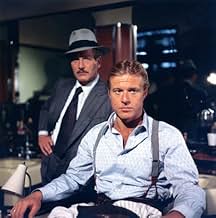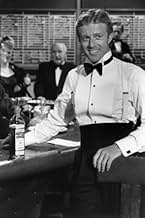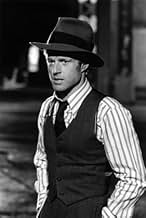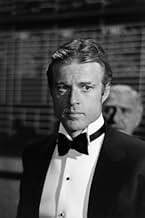Dois golpistas se reúnem para obter o melhor golpe.Dois golpistas se reúnem para obter o melhor golpe.Dois golpistas se reúnem para obter o melhor golpe.
- Ganhou 7 Oscars
- 18 vitórias e 6 indicações no total
Robert Earl Jones
- Luther Coleman
- (as Robertearl Jones)
James Sloyan
- Mottola
- (as James J. Sloyan)
Resumo
Reviewers say 'The Sting' is celebrated for its intricate plot, charismatic performances by Paul Newman and Robert Redford, and nostalgic charm of the 1930s setting. The film's clever con schemes, dynamic character interactions, and witty dialogue are frequently highlighted. The iconic ragtime music enhances the atmosphere, while meticulous production design immerses viewers. Despite some criticisms regarding historical inaccuracies and predictability, 'The Sting' is widely regarded as a timeless classic.
Avaliações em destaque
A delicious wheeze from start to finish. Certainly a film that leaves you thinking that you'd like to have been in Henry's gang and played a part in separating Lonnegan from his dough. The editing is pin sharp and beautifully cast with a superb musical track to keep you company. The framing, the photography, the pace all dovetail exquisitely and if you feel left outside of the game plan in your first viewing, never fear, the second time of watching, you'll enjoy it just as much but it will mean more. Certainly it's a film you'll want to see a second time. At least. Oscars rightly by the handful and nominations are full deserved to combine for a winning performance by all concerned. Definitely in my top fifty of all time.
In Joliet, Illinois in 1936 the murder of a 'grifter' causes repercussions throughout the underworld. Grifters are the small-time con artists who work the streets. They know and respect one another, and the death of Luther brings all the con men from far and wide together in a plan of revenge. Doyle Lonnegan is the New York Irish gangster who ordered Luther's execution, so the grifters target him for the "big con".
"The Sting" was devised as a follow-up to "Butch Cassidy", reuniting Newman and Redford as lovable, wisecracking rogues. The motivation behind the project may have been cynical box-office manipulation, but the resulting film is a beauty. The two stars make a great team, and multi-faceted confidence tricks adorn the plot in Byzantine complexity.
Lonnegan (Robert Shaw) has two prominent personality traits - greed and cruelty. A con is put together which will use these characteristics against their owner. The best way to hurt Lonnegan is to dupe him out of his money, because the sharks of the criminal fraternity will turn on him once they see that he's been 'had'. It is essential that Lonnegan must never know that this was a scam, because if he did, he would pursue a vendetta against our heroes. He must believe that he lost his money through his own stupidity, and that the men who took it are now dead.
The opening scenes emphasise the harshness of a world in which powerful crooks fleece ordinary joes, but also stress the warmth of the social bond which unites the small-time thieves. Mottola is a runner for Lonnegan's operation, a heartless dandy who steals a desperate man's dough (or so he thinks). The gambling dens ruthlessly swindle Hooker out of his money, but Hooker makes no trouble for the croupier, a guy just like himself who is merely trying to survive.
Redford plays Hooker to perfection. He is the handsome, charming 'man of the people'. There is no malice in him, and yet he spends his life ducking, diving and dodging lead. Luther was his father figure, and we see Hooker transfer his filial allegiance to Gondorff.
The film is crammed with technical cleverness. Whoever went out and scouted for locations did a great job, because the gritty 1930's look is wonderful. If the streets around the bookie's shop were 'faked' on a back lot, then this alone would make "The Sting" outstanding. Watch the urban period detail as Lonnegan goes across to place his first bet, and again at the start of "The Wire". Hooker suddenly realises that Luther is dead, and we see 'the penny drop' by means of a very simple but very effective device - the camera zooms back. No redundant dialogue, no over-acting. The panoramic view from above the rail tracks is achieved by 'masking in' a photograph of old Joliet, to create a convincing skyline. During the poker game on the train, the focus is thrown from Lonnegan's cards to Gondorff's eyes. We know that Gondorff knows that Lonnegan is cheating.
The music cannot go unmentioned. Apart from being exquisite, it contributes a major part of the film's overall feel. "The Sting" introduced the piano rags of Scott Joplin to a mass audience, and their popularity has not diminished over the ensuing decades. Composed perhaps forty years before the events they illustrate, and therefore 'wrong' from a period point of view, the pieces are none the less perfect, and the film is unimaginable without them. As a fun accompaniment to the music, the film contains various silent-era 'wipes'. Watch for the changes of scene for the iris-ins and iris-outs, and vertical and horizontal wipes.
David Ward's script is intelligent and intricate. The 'big con' has safety features built into it, such as the well-worked 'shut-out'. In order for the audience to take the swindlers to their hearts, it is necessary to depict the cops as venal, immoral and downright sleazy. Local dick Snyder is all of this, and more, his character being a masterpiece of dimwitted malevolence.
Eileen Brennan (Captain Lewis in "Private Benjamin") plays Billie, Gondorff's partner. She turns in a performance of cool assurance, one of the film's subtler treats. Charles Dierkop is simply marvellous as Floyd. This veteran of "Butch Cassidy" has hardly any dialogue, but he makes Floyd central to the film's comic purpose - and does it all with nuances of gesture. The FBI agents are great. Wearing straw boaters more than a decade after straw boaters ceased to be cool, and persisting with them even in torrential rain, the G-men are the archetype of Hooverian 'squareness'.
It may be fanciful, but are there passing references to Hitchcock's "Strangers On A Train"? The carrousel may be stretching a point, but what of Mottola's feet at the start, wearing Robert Walker's shoes?
"The Sting" is a splendid film. The plot may perform bewildering gyrations, Robert Shaw's Irish accent may be somewhat shaky, and Solino may be an assassin too far - but the whole of this complicated contraption works, and works well. I can recall, back in 1974, an excited cinema audience actually cheering and shouting at the screen.
"Seems worthwhile, doesn't it?"
"The Sting" was devised as a follow-up to "Butch Cassidy", reuniting Newman and Redford as lovable, wisecracking rogues. The motivation behind the project may have been cynical box-office manipulation, but the resulting film is a beauty. The two stars make a great team, and multi-faceted confidence tricks adorn the plot in Byzantine complexity.
Lonnegan (Robert Shaw) has two prominent personality traits - greed and cruelty. A con is put together which will use these characteristics against their owner. The best way to hurt Lonnegan is to dupe him out of his money, because the sharks of the criminal fraternity will turn on him once they see that he's been 'had'. It is essential that Lonnegan must never know that this was a scam, because if he did, he would pursue a vendetta against our heroes. He must believe that he lost his money through his own stupidity, and that the men who took it are now dead.
The opening scenes emphasise the harshness of a world in which powerful crooks fleece ordinary joes, but also stress the warmth of the social bond which unites the small-time thieves. Mottola is a runner for Lonnegan's operation, a heartless dandy who steals a desperate man's dough (or so he thinks). The gambling dens ruthlessly swindle Hooker out of his money, but Hooker makes no trouble for the croupier, a guy just like himself who is merely trying to survive.
Redford plays Hooker to perfection. He is the handsome, charming 'man of the people'. There is no malice in him, and yet he spends his life ducking, diving and dodging lead. Luther was his father figure, and we see Hooker transfer his filial allegiance to Gondorff.
The film is crammed with technical cleverness. Whoever went out and scouted for locations did a great job, because the gritty 1930's look is wonderful. If the streets around the bookie's shop were 'faked' on a back lot, then this alone would make "The Sting" outstanding. Watch the urban period detail as Lonnegan goes across to place his first bet, and again at the start of "The Wire". Hooker suddenly realises that Luther is dead, and we see 'the penny drop' by means of a very simple but very effective device - the camera zooms back. No redundant dialogue, no over-acting. The panoramic view from above the rail tracks is achieved by 'masking in' a photograph of old Joliet, to create a convincing skyline. During the poker game on the train, the focus is thrown from Lonnegan's cards to Gondorff's eyes. We know that Gondorff knows that Lonnegan is cheating.
The music cannot go unmentioned. Apart from being exquisite, it contributes a major part of the film's overall feel. "The Sting" introduced the piano rags of Scott Joplin to a mass audience, and their popularity has not diminished over the ensuing decades. Composed perhaps forty years before the events they illustrate, and therefore 'wrong' from a period point of view, the pieces are none the less perfect, and the film is unimaginable without them. As a fun accompaniment to the music, the film contains various silent-era 'wipes'. Watch for the changes of scene for the iris-ins and iris-outs, and vertical and horizontal wipes.
David Ward's script is intelligent and intricate. The 'big con' has safety features built into it, such as the well-worked 'shut-out'. In order for the audience to take the swindlers to their hearts, it is necessary to depict the cops as venal, immoral and downright sleazy. Local dick Snyder is all of this, and more, his character being a masterpiece of dimwitted malevolence.
Eileen Brennan (Captain Lewis in "Private Benjamin") plays Billie, Gondorff's partner. She turns in a performance of cool assurance, one of the film's subtler treats. Charles Dierkop is simply marvellous as Floyd. This veteran of "Butch Cassidy" has hardly any dialogue, but he makes Floyd central to the film's comic purpose - and does it all with nuances of gesture. The FBI agents are great. Wearing straw boaters more than a decade after straw boaters ceased to be cool, and persisting with them even in torrential rain, the G-men are the archetype of Hooverian 'squareness'.
It may be fanciful, but are there passing references to Hitchcock's "Strangers On A Train"? The carrousel may be stretching a point, but what of Mottola's feet at the start, wearing Robert Walker's shoes?
"The Sting" is a splendid film. The plot may perform bewildering gyrations, Robert Shaw's Irish accent may be somewhat shaky, and Solino may be an assassin too far - but the whole of this complicated contraption works, and works well. I can recall, back in 1974, an excited cinema audience actually cheering and shouting at the screen.
"Seems worthwhile, doesn't it?"
At first sight, THE STING appears to be nothing more than a television movie. It is entirely plot-driven with no real stand out characters or personalities. What makes the film work is excellent production design and a delightfully clever plot filled with many surprises. The movie is feather-weight emotionally, but the depth of the "con" and the way it is fashioned by screenwriter David Ward leaves you with a pleasant experience.
This is more Redford's film than Newman's, who reunite with George Roy Hill, director of BUTCH CASSIDY AND THE SUNDANCE KID. The legendary actors were more flesh and blood in that film, but here, they are merely players who carry the story along. With lesser actors, THE STING may have been a forgettable piece of work. Redford does all of the dirty work after Newman's initial "hook", but the omniscient presence of Newman, as big-time grifter "Henry Gondorff" exists throughout. A mysterious gloved character, a crooked cop, the FBI, and a seemingly bigger con-man "Doyle Lonnegan" (played by the late, great Robert Shaw) are some of the players who are involved in some events that seem to be manipulated by an unseen force. Is Newman as good as he claims in trying to clean out Shaw? We'll see.
The film is shot simply by Hill. No tricky angles or contrived camera movements are used. The action takes place simply in front of us. The production design by Henry Bumstead and James Payne recreates old-time Chicago through the use of built sets, matte paintings of a smaller sky-line, and some location shots. It gives the film an almost artificial look which is fitting considering it is a direct homage to the 1930's and the gangster pictures that so dominated that decade. The story is even furthered by title pages describing "the set-up, the hook, and the sting". They are turned like pages in a book, adding a drop of elegance to a crooked world. An iris is even employed in some scenes.
THE STING is definitely lightweight entertainment. It does not provoke much thought or insight into what is happening on screen. Fun is the word for this amusing little film that depicts a masterful plan for a big steal which would be impossible to pull off today. Look out for Ray Walston in a hilarious role announcing horse races and their results as they are "happening" just after receiving word of the "real" race results from a back room in the betting house. These are good con-men.
RATING: ***
This is more Redford's film than Newman's, who reunite with George Roy Hill, director of BUTCH CASSIDY AND THE SUNDANCE KID. The legendary actors were more flesh and blood in that film, but here, they are merely players who carry the story along. With lesser actors, THE STING may have been a forgettable piece of work. Redford does all of the dirty work after Newman's initial "hook", but the omniscient presence of Newman, as big-time grifter "Henry Gondorff" exists throughout. A mysterious gloved character, a crooked cop, the FBI, and a seemingly bigger con-man "Doyle Lonnegan" (played by the late, great Robert Shaw) are some of the players who are involved in some events that seem to be manipulated by an unseen force. Is Newman as good as he claims in trying to clean out Shaw? We'll see.
The film is shot simply by Hill. No tricky angles or contrived camera movements are used. The action takes place simply in front of us. The production design by Henry Bumstead and James Payne recreates old-time Chicago through the use of built sets, matte paintings of a smaller sky-line, and some location shots. It gives the film an almost artificial look which is fitting considering it is a direct homage to the 1930's and the gangster pictures that so dominated that decade. The story is even furthered by title pages describing "the set-up, the hook, and the sting". They are turned like pages in a book, adding a drop of elegance to a crooked world. An iris is even employed in some scenes.
THE STING is definitely lightweight entertainment. It does not provoke much thought or insight into what is happening on screen. Fun is the word for this amusing little film that depicts a masterful plan for a big steal which would be impossible to pull off today. Look out for Ray Walston in a hilarious role announcing horse races and their results as they are "happening" just after receiving word of the "real" race results from a back room in the betting house. These are good con-men.
RATING: ***
Doyle Lonnegan (brilliantly played by Robert Shaw) is a mean and vengeful villain, his retribution leads to you, losing a friend (he's after you too), you find your way to Henry Gondorff (coolly performed by Paul Newman), a sting is conjured around a horse (or horses), then you gather several cons, play let's pretend. The irritation is lieutenant William Snyder (played by the excellent Charles Durning), he's on your tail, and it's not long, before he'll find you, but there are ways to cause distractions, to pervert his satisfactions, as Johnny Hooker (Robert Redford nails it to perfection) you deliver quite a blinder.
Perpetual perfection that continues to deliver to this day.
Perpetual perfection that continues to deliver to this day.
Small time conmen Johnny Hooker and Luther Coleman unwittingly scam a runner for Chicago main man Doyle Lonnegan. When Luther is murdered, Hooker goes on the run and seeks out Luther's old friend Henry Gondorff to help him put together a major sting to take revenge on Lonnegan. However with so much heat on Hooker and the stakes so high can they pull it off and get away clean?
Almost a follow up to Butch and Sundance, this film partners the stars of the day Newman and Redford to good effect. The story is a little less fun but still very enjoyable to watch as it builds to a great finale. The use of chapters ran the risk of fragmenting the film into bits but instead it really helps set it out and makes it more manageable. Although it is not as light hearted and jovial as the theme music suggests it still manages to flow nicely with the slightly darker drama not spoiling anything but only serving to make it feel more grown up.
The cast are all very good and make the film easy to watch. Redford comes off the best in terms of characters and his role really suits both his carefree attitude (the start of the film) but also his more serious side (the rest of the film). Newman has a lesser role that perhaps doesn't suit him quite as well, but he does have several really good scenes (the hustles) where he does very good work. Shaw's accent is a little heavy at first but I got used to it and it worked for me and he was a really good foil for Redford/Newman. The support cast including Durning, Walston, Gould, Jones and others all do good work.
The direction and use of music is really good and the sense of period is well crafted and doesn't just feel like it was painted on. I'm not sure if it deserved Best Picture or not because I don't know what the rest of the field was for that year but it is a really enjoyable film that is quite fun to watch several times even 30 years later and isn't that the main thing?
Almost a follow up to Butch and Sundance, this film partners the stars of the day Newman and Redford to good effect. The story is a little less fun but still very enjoyable to watch as it builds to a great finale. The use of chapters ran the risk of fragmenting the film into bits but instead it really helps set it out and makes it more manageable. Although it is not as light hearted and jovial as the theme music suggests it still manages to flow nicely with the slightly darker drama not spoiling anything but only serving to make it feel more grown up.
The cast are all very good and make the film easy to watch. Redford comes off the best in terms of characters and his role really suits both his carefree attitude (the start of the film) but also his more serious side (the rest of the film). Newman has a lesser role that perhaps doesn't suit him quite as well, but he does have several really good scenes (the hustles) where he does very good work. Shaw's accent is a little heavy at first but I got used to it and it worked for me and he was a really good foil for Redford/Newman. The support cast including Durning, Walston, Gould, Jones and others all do good work.
The direction and use of music is really good and the sense of period is well crafted and doesn't just feel like it was painted on. I'm not sure if it deserved Best Picture or not because I don't know what the rest of the field was for that year but it is a really enjoyable film that is quite fun to watch several times even 30 years later and isn't that the main thing?
Oscars Best Picture Winners, Ranked
Oscars Best Picture Winners, Ranked
See the complete list of Oscars Best Picture winners, ranked by IMDb ratings.
Você sabia?
- CuriosidadesPaul Newman and Robert Redford were each paid $500,000 for their role, the highest rate for an actor working at that time. Adjusted for inflation, that is equal to about $3 million (2022). The year before this Marlon Brando earned $3 million from Último Tango em Paris (1972) but that included profit participation.
- Erros de gravaçãoIn the bathroom, Hooker can be seen saying, "He didn't tell me you was a fuck-up either." This has been looped to replace it with the less profane "He didn't tell me you was a screw-up either." (The grammar error is scripted.)
- Citações
Johnny Hooker: Can you get a mob together?
Henry Gondorff: After what happened to Luther, I don't think I can get more than two, three hundred guys.
- Cenas durante ou pós-créditosThe opening animated logo for Universal Pictures is in 1930s style, matching the movie's setting, instead of the 1970s version.
- ConexõesFeatured in Oscars, Actors and The Exorcist (1974)
Principais escolhas
Faça login para avaliar e ver a lista de recomendações personalizadas
- How long is The Sting?Fornecido pela Alexa
- Why does Lonnegan speak with a Northern Irish accent in The Sting?
- What are some interesting facts about horses?
- How could such a huge con team possibly get away with such an operation in the The Sting?
Detalhes
Bilheteria
- Orçamento
- US$ 5.500.000 (estimativa)
- Faturamento bruto nos EUA e Canadá
- US$ 156.000.000
- Faturamento bruto mundial
- US$ 156.000.000
- Tempo de duração2 horas 9 minutos
- Cor
- Proporção
- 1.85 : 1
Contribua para esta página
Sugerir uma alteração ou adicionar conteúdo ausente





